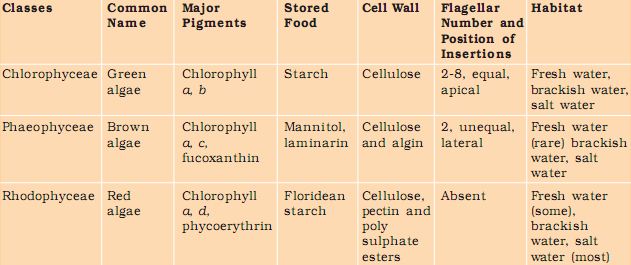Plant Kingdom MCQ/Objective questions Chapter 3 Biology Class 11
1. Blue-green alga belongs to the group:
-
- a. Plantae.
- b. Animalia.
- c. Algae.
- d. Cyanobacteria.
2. Plant kingdom comprises:
- a. Algae.
- b. Bryophytes and pteridophytes.
- c. Angiosperms and gymnosperms.
- d. All.
Table of Contents
3. “Artificial classification” by Linnaeus was not accurate because:
- a. It gave equal weightage to vegetative as well as the sexual mode of reproduction.
- b. It was primarily based upon superficial morphological character like color, shape, and number of leaves.
- c. It did not consider internal structure like anatomy, embryology, phytochemistry.
- d. All.
4. Why vegetative mode of reproduction does not weigh equally to the sexual mode of reproduction.
- a. Vegetative propagation is common in the plant kingdom.
- b. Vegetative reproduction is not so complicated, like sexual reproduction.
- c. Environmental factors easily alter vegetative characters.
- d. None.
5. Classification of the flowering plant by Bentham and Hooker is:
- a. Natural classification.
- b. Artificial classification.
- c. None.
6. Phylogenetic classification seeks:
- a. The similarity in sexual mode of reproduction.
- b. The similarity in the asexual mode of reproduction.
- c. Evolutionary relationship among organisms.
- d. None.
7. The cytological classification relies on cytological information like:
- a. Chromosome number.
- b. Chromosome structure.
- c. Chromosome behavior.
- d. All.
8. Chemotaxonomy uses to find the relationship in organisms:
- a. Chemical constituents.
- b. Reaction with chemical reagents.
- c. The affinity of plants towards some chemicals.
- d. None.
9. Chlorophyll containing organelle of algae is:
- a. Chloroplast.
- b. Plastid.
- c. Thalloid.
- d. Chromoplast.
10.
11. Algae reproduce :
- a. By fragmentation.
- b. Asexually by zoospore formation.
- c. Sexually.
- d. None.
12. Which among these is an alga?
- a. Volvox.
- b. Ulothrix.
- c. Spirogyra.
- d. All.
13. The biggest carbon dioxide fixator on earth is?
- a. Plants other than alga.
- b. Algae.
- c. Cyanobacteria.
- d. None.
14. Edible algae is:
- a. Laminaria.
- b. Porphyra.
- c. Sargassum.
- d. All.
15. Hydrocolloid forming alga is:
- a. Algin (Brown alga).
- b. Carrageen (red alga).
- c. Sargassum.
- d. a and b.
16. Chemical laboratories obtain agar from which alga:
- a. Algin (Brown alga).
- b. Carrageen (red alga).
- c. Sargassum.
- d. Gelidium.
17. We classify alga based on :
- a. Colour.
- b. Type of spore formation.
- c. Morphology.
- d. All above..

18. Bryophytes include:
- a. Liverworts.
- b. Mosses.
- c. Both a and b.
- d. Spirogyra.
19. Amphibians of the plant kingdom are:
- a. Algae.
- b. Bryophytes.
- c. Pteridophytes.
- d. Gymnosperms.
20. Following plants plays an important role in plant succession:
- a. Algae.
- b. Bryophytes.
- c. Pteridophytes.
- d. Gymnosperms.
21. feature of Bryophytes among these are:
- a. Thalloid body with base.
- b. Lack of roots, stems, and leaves.
- c. Prominent haploid generation.
- d. All.
22. Vascular tissues in plants (xylem and phloem) first appear in:
- a. Bryophytes.
- b. Pteridophytes.
- c. Gymnosperms.
- d. Angiosperms.
23. feature of pteridophytes among these are:
- a. Prominent diploid generation (sporophyte).
- b. Roots, stems, and leaves.
- c. Prominent haploid generation.
- d. All.
24. Examples of Pteridophytes are:
- a. Ferns.
- b. Selaginella.
- c. Equisetum.
- d. All.
25. Meaning of gymnosperm is:
- a. Full seed.
- b. Naked seed.
- c. Hidden seed.
- d. Round seed.
26. Gymnosperms among these are
- a. Conifer.
- b. Pinus.
- c. Cedar.
- d. All.
27. Plant group that has mostly ornamental plants are:
- a. Pteridophytes.
- b. Gymnosperms.
- c. Angiosperms.
- d. None.
28. Flowering plants belong to:
- a. Pteridophytes.
- b. Gymnosperms.
- c. Angiosperms.
- d. None.
29. Prominent stage in angiosperm is:
- a. Independent sporophyte generation.
- b. Dependent gametophyte generation.
- c. Both.
- d. None.
- The Living world MCQ Biology Questions
- Biological Classification MCQ Questions with answers
- Plant Kingdom MCQ Biology Class Eleven
- Animal Kingdom MCQ Biology
- Morphology of Flowering Plants MCQ
- Anatomy of Flowering Plants MCQ Biology
- Structural Organisation in Animals MCQ
Answers:
| 1. d | 9. c | 17. d | 25. b |
| 2. d | 10 | 18. c | 26. d |
| 3. d | 11. b | 19. b | 27. b |
| 4. c | 12. d | 20. a | 28. c |
| 5. a | 13. b | 21. d | 29. a |
| 6. c | 14. d | 22. b | |
| 7. d | 15. d | 23. d | |
| 8. a | 16. d | 24. d |
Plant Kingdom MCQ/Objective questions Chapter 3 Biology Class 11
Ref: Chapter 3, NCERT.